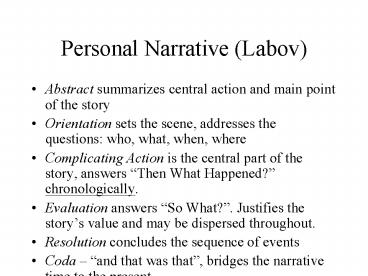Personal Narrative Labov - PowerPoint PPT Presentation
1 / 13
Title: Personal Narrative Labov
1
Personal Narrative (Labov)
- Abstract summarizes central action and main point
of the story - Orientation sets the scene, addresses the
questions who, what, when, where - Complicating Action is the central part of the
story, answers Then What Happened?
chronologically. - Evaluation answers So What?. Justifies the
storys value and may be dispersed throughout. - Resolution concludes the sequence of events
- Coda and that was that, bridges the narrative
time to the present.
2
Applied to News
- Abstract lead or intro, preceded by headline
- Orientation who, what, when, where. May be
elaborated throughout story. - Action the main narrative, but seldom told
chronologically. - Evaluation establishes significance of story,
possibly in lead - Resolution there is not often a resolution in
news, and if there is, its in the lead. - Coda no coda in news stories.
3
News Narrative Discourse
- Radical discontinuity of time.
- Weak cohesion.
- Each paragraph a separable unit. Isolated chunks
of information. Lack of link devices. - Lack of resolution.
4
News Story Elements
- Abstract lead sentence and headline.
- Attribution where the story came from.
- Episodes and events.
- Events describe actors and action, setting and
attribution. - Background events prior to current action
- Commentary
- Follow-up actions subsequent to the main action.
5
Explaining News Time
- News Values (e.g. recency, immediacy,frequency,
unexpectedness, novelty, elite-ness etc.). - Deadlines or cycles (continuity, competition,
predictability, prefabrication).
6
News A Multi-Authored Text
- Heteroglossia mixing of many voices (Bakhtin)
embedding - Interviews, face-to-face, phone, internet etc.
- Public addresses, Press conferences
- Written text of spoken addresses
- Organizationally produced documents Press
releases - Earlier stories on topic
- News agency copy
- Journalists notes from all the above
7
Inverted Pyramid
- Information is arranged from the most important
to the least important - Saves the reader TIME, and the paper SPACE
- Is headed by the Lead Paragraph
- Importance is determined by RELEVANCE,
USEFULNESS, INTEREST - Story answers the questions who, what, when,
where, why, how.
8
Alternate Leads
- Immediate-Identification emphasizes the who.
- Delayed-Identification emphasizes other elements
e.g. the action or event. - Summary leads do not highlight specific action
- Multiple-element lead covers a number of distinct
actions
9
Story Organization After the Lead
- Introduce additional important information that
was not in the lead - Indicate significance or so-what factor
- Elaborate on information in lead
- Introduce new information in the order of
importance - Develop the ideas in the same order in which they
have been introduced - One new idea for each paragraph. s
10
News Narrative
- Vivid scenes
- Dialogue
- Foreshadowing (advertising whats coming)
- Anecdotes
11
Focus Structure
- Alternative to pyramid
- Focus on individual or group that represents a
bigger population - Transition to a theme or nut paragraph
- Add foreshadowing
- Add so-what
- Add to-be-sure
- Mix exposition (facts) with narration
- Has an ending, conclusion
12
Speeches, Conferences, Meetings.
- Preparation
- Visit to the morgue for background on
speaker/topic. - Check national database such as Nexis/Lexis.
- Check if there is advance copy of speech or
agenda - Check speakers office or associates.
- Get interview of speaker/chair before/after
speech. - Note other journalists questions.
- Record direct quotes.
13
Writing the Story
- Lead
- Direct quotes
- Background
- Headings
- Get reactions
- Sidebar possibilities
- Find something unusual/interesting































